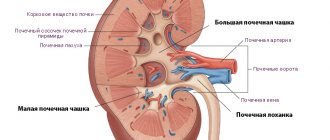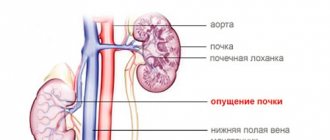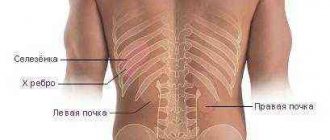Pregnancy is a period in a woman’s life when the body requires additional energy and strength. Nephroptosis and pregnancy have a certain relationship, since at this time there is a risk of the occurrence or exacerbation of chronic diseases, including kidney diseases associated with natural changes in the body on the eve of childbirth.
Features of nephroptosis and causes of its occurrence in pregnant women
In their natural, physiological place, the kidneys are kept inside the abdominal cavity not thanks to the intestines. Each of them is located in a separate renal bed formed by the abdominal ligaments, fibrous bands and fascia, and are also additionally supported by intra-abdominal pressure, which is created by the abdominal muscle group, deep back muscles, oblique muscles of the trunk and the diaphragm.
A note on the topic. The kidneys are not stationary, but constantly move, following the diaphragm moving during breathing. Such constant rhythmic fluctuations help improve renal blood flow, urine production and excretion. That is why exercise therapy for kidney pathology necessarily includes breathing exercises.
Normally, the difference in the vertical position of the kidneys is up to 2 cm. The fact that the right kidney is lower than the left is explained by the anatomical location of the liver and the naturally weak right renal bed.
The latter fact explains why nephroptosis on the right during pregnancy is more common than on the left. By the way, exactly the same pattern can be seen in both men and non-pregnant women.
Carrying heavy objects during pregnancy can lead to nephroptosis
Kidney prolapse during pregnancy occurs for the following reasons:
- initial (before pregnancy) weakness of the torso muscles due to a sedentary lifestyle;
- increased elasticity of all ligaments, stretching of the fibrous capsule, weakening of the abdominal muscle fibers and deep back muscles, as well as a drop in intra-abdominal pressure caused by changes in hormonal levels for the normal course of pregnancy;
- a history before pregnancy or development during pregnancy of infectious kidney diseases and/or damage to the upper third of the ureter;
- excessive thinness and lack of sufficient (normal) amount of subcutaneous fat;
- untreated nephroptosis that occurred during a previous pregnancy;
- injuries leading to the development of hemorrhage in the perinephric tissue;
- disregard for the ban on excessive physical activity and carrying heavy objects;
- Chernogubov-Ehlers-Danlos syndrome is a hereditary pathology of collagen synthesis, which results in hyperelasticity of connective tissues and skin.
Advice. For those who are expecting the birth of a baby for the first time and who have already been diagnosed with kidney prolapse, it is useful to know that after childbirth it is necessary to undergo treatment and return the organ to its normal location. Otherwise, nephroptosis can cause serious complications. It may be possible to do without them, but during the next pregnancy the migration of the organ will already have significant proportions that threaten health.
Degrees and symptoms of a “wandering” kidney
Normal and nephroptosis of the right kidney III degree
In the classification of nephroptosis, there are three degrees of prolapse:
- I – the kidney that has changed its position is palpated through the abdomen at the moment of inhalation, and during exhalation it “hides” behind the edge of the rib;
- II – the kidney can be easily palpated in a standing position, but cannot be palpated while lying on the back;
- III – migration of the kidney reaches such a size that it no longer returns to its physiological position, no matter the position of the body.
Signs of nephroptosis in pregnant women
Stage I nephroptosis can be asymptomatic, but thin people should be on alert
Here are some signs that indicate something is wrong:
- periodically occurring, dull, aching pain and discomfort in the area just above the lower back from an organ that has begun to rotate or drift;
- an increase in the number and severity of painful attacks, while the pain begins to radiate to the lower part of the abdominal cavity;
- causeless weight loss;
- persistent constipation or diarrhea;
- nausea, vomiting;
- the appearance of bloody traces in the urine;
- nervous breakdowns that developed into a stable depressed state.
Stage III nephroptosis is characterized by signs of pyelonephritis, orthostatic hypertension (blood pressure increases, but only in an upright position), impaired urine outflow, and periodic bleeding from the urinary tract.
Important! If there is a decrease in the daily amount of urine or other disturbances during urination, a pregnant woman should immediately go to an appointment and inform the doctor about it.
Degree of disease development
There are three stages of organ prolapse:
- Stage 1 nephroptosis is asymptomatic. When the patient inhales, the doctor feels a shift of the organ by 1.5 centimeters to the right side;
- Nephroptosis 2 degrees - characterized by attacks of pain in the lower back. Urine becomes cloudy. There is a displacement of two centimeters. There is a malfunction of the organ. Urinalysis shows protein with increased red blood cell content. When changing the position of the body, the organ falls into place;
- Nephroptosis of the 3rd degree - severe pain occurs, radiating to the abdominal area. The descent occurs lower than a third of the spine and does not return to its place when changing body position.
Nephroptosis and pregnancy - dangers for the woman and the unborn baby
In most cases, pregnancy with nephroptosis proceeds normally. Migration of degrees I-II or rotation of the kidney does not have a detrimental effect on the development of the fetus. However, for the mother, the presence of nephroptosis becomes a problem that must be solved as quickly as possible.
Organ prolapse will certainly progress, and may result in one or more complications:
- acute pyelonephritis;
- development of renal failure in the presence of chronic pyelonephritis;
- elongation of the ureter, which inevitably causes its thinning and development of an inflammatory process in the walls;
- torsion of the ureter, accompanied by a violation of the outflow of urine, stopping it or throwing it back into the kidney cavity;
- manifestation of urolithiasis;
- hypertensive crises that threaten a stroke or heart attack.
Before you plan to conceive, first return the prolapsed kidney to its natural position
People often ask the question online: is it possible to get pregnant knowing that you already have nephroptosis?
Kidney prolapse and pregnancy are not the best combination, and it is not worth the risk. It is one thing when the migration of an organ began unexpectedly during pregnancy, and quite another when a woman plans to conceive and neglects the presence of this pathology, especially if II-III degree of nephroptosis is diagnosed.
Many people believe that an enlarged uterus will lift the kidney up and support it there. However, this does not happen in most cases.
Attention! The cost of conception with stage III nephroptosis is a possible spontaneous abortion due to early and constant hypertonicity of the uterus caused by the unusual position of the renal organ.
Surgical intervention during pregnancy using a minimally invasive laparoscope is difficult or impossible, and surgical anesthesia can have a detrimental effect on the development of the fetus. Therefore, any operation to return the kidney to its natural position is performed only if there is a real threat to the mother’s life.
Consequences
Possible consequences of the disease include pyelonephritis, which occurs against the background of obstructed urine outflow and stagnation in the renal pelvis.
Possible consequences of the disease include:
- pyelonephritis, which occurs against the background of obstructed urine outflow and stagnation in the renal pelvis;
- urolithiasis manifests itself on the same basis: accumulation of urine leads to sedimentation of particles and the formation of stones;
- Arterial hypertension is a pathology caused by increased pressure in the kidneys.
Important! The diagnosis of arterial renal hypertension cannot be treated with tablets for hypertension patients! An examination by a specialist and the prescription of special medications are required - medications for high blood pressure taken uncontrolled will only worsen the patient’s situation
Treatment of nephroptosis during pregnancy and after childbirth
After a survey, external examination and palpation of the kidney, which is “suspected” of migration, an ultrasound will need to be done to confirm the diagnosis. After which the pregnant woman will be asked to regularly take urine tests and undergo follow-up ultrasound examinations until delivery.
Variants of Hare and Child poses - yoga asanas for nephroptosis in pregnant women
The standard instructions for nephroptosis during pregnancy are as follows:
- Medication support - Canephron . You will have to take the pills before giving birth. Your doctor will advise you on the dosage and regimen.
- Pain relief - daily practice of the knee-elbow pose with the buttocks raised up. “Simple” kneeling with emphasis on the palms or elbows is ineffective. The correct positions are shown in the photo above. If your stomach interferes with being in these positions comfortably, then spread your knees to the sides. Hold your heels in a way that is comfortable for you - either together or apart. The number of repetitions during the day and the duration of holding the pose depends on the degree of prolapse and the severity of the pain syndrome.
- Maintaining muscle tone - a complex of exercise therapy for pregnant women (depending on the trimester).
Attention! In case of renal ptosis of the second degree, the physical therapy methodologist must create an individual set of exercises and give detailed explanations for their implementation. With III nephroptosis, doing gymnastics is not only too late, but also strictly prohibited.
- Dietary recommendations - avoid fatty and salty foods, spicy marinades and smoked meats. It is also necessary to maintain a daily drinking regime and include more natural (!) cranberry juice in your daily diet.
- Maintenance therapy - wearing a bandage. You can learn from the video how to choose the right one, and most importantly, how to put on the bandage correctly.
Symptoms of drooping kidneys
The appearance of nephroptosis is characterized by the following signs:
- Severe pain in the lumbar back, which intensifies with movement;
- Weight loss caused by decreased appetite is common;
- Increased body temperature may occur;
- Nervous excitability;
- Increased blood pressure;
- The appearance of bloody discharge in urine;
- Disruption of the functioning of the housing complex.
Kidney prolapse and pregnancy are closely related to each other.
These symptoms only indirectly indicate the occurrence of the disease. For an accurate diagnosis, it is necessary to undergo tests and do an ultrasound examination. Increased levels of protein, white and red blood cells indicate the onset of the disease.
Prevention of nephroptosis in expectant mothers
As soon as a woman finds out that she is pregnant, it is necessary to immediately begin strengthening the muscular corset of the torso, especially if this is not the first pregnancy. For those who play sports or lead an active lifestyle, it is recommended to reduce the level of physical activity, but under no circumstances give up training!
After childbirth, even if there was no prolapse of the renal organ, you definitely need to do exercise therapy for a couple of months. The main goal of these workouts is not to lose extra pounds, which is of course also important, but to restore the normal tone of all the muscles of the body. If kidney prolapse occurs during pregnancy, then maximum efforts must be made, including surgery, which must be done as soon as the body returns to normal.
When planning a pregnancy, it is important to get your health in order, not forgetting to pay attention to physical training. Strong trunk muscles are the key to a successful pregnancy and easy childbirth.
And in conclusion, we are posting a video with simple gymnastic exercises that need to be performed in the third trimester of pregnancy.
Why is this phenomenon dangerous?
This condition can provoke:
- stagnation of urine in the ureters, which leads to the proliferation of bacteria and, as a consequence, to pyelonephritis;
- dilation of the renal pelvis due to accumulation of urine (hydronephrosis);
- formation of stones in the renal pelvis;
- renal failure (impaired formation and (or) excretion of urine by the kidneys).
Instrumental diagnostics
The first instrumental examination, which can already determine the main tactics for treating renal nephroptosis, is an ultrasound scan performed in various projections. In addition to basic information on the location of the organ and the degree of its deviation from the anatomically correct position, ultrasound examination reveals foci of inflammation and possible expansion of the entire collecting apparatus.
Doppler ultrasound (USDG), which examines the vessels adjacent to the kidneys, shows how well the circulatory system copes with supplying the organs with blood, assesses the speed of blood flow and the capacity of the vessels.
Excretory urography, that is, an x-ray of the urinary complex as a whole, indicates the depth of descent of the kidney towards the pelvis in relation to the lumbar vertebrae. This allows us to draw a conclusion about the stage that the disease has reached and detect all violations in the process of removing urine from the body.
Excretory urography for nephroptosis allows you to assess the degree of pathological prolapse of the kidney in relation to the lumbar vertebrae, and rotation of the kidney. The X-ray method of examining the urinary system allows one to estimate the time of urine excretion, identify anatomical lesions of the urinary organs, and monitor the dynamics of urine excretion.
In some cases, and if a detailed, layer-by-layer study of the urinary apparatus is necessary, I can recommend an MRI of the kidneys to the patient, but due to the paid examination, it is not included in the list of mandatory manipulations.
Treatment during pregnancy
Nephroptosis can occur before, after, or during gestation. A woman who wants to become a mother needs to undergo a thorough check of her body for diseases. When a disease is detected during pregnancy, women more often turn to a gynecologist and urologist.
It is very important to detect the disease in time, since in the initial stages it will not affect the development of the fetus. Often the disease is a consequence of uterine pressure and is temporary.
If the disease is detected, it is necessary to reduce heavy physical activity. Self-medication is strictly prohibited. It is very important to protect your back from the cold.
If acute pain occurs, the woman should take a knee-elbow position. In this position, there is no pressure from the uterus on the organ. If a pregnant woman develops a disease, bed rest is recommended. You should limit your intake of salty and protein foods.
Features during pregnancy
Nephroptosis can cause disruption of the urinary system. Difficulty urinating can in turn cause the following complications:
- Kidney inflammation;
- Dilation of the calyx and renal pelvis;
- Kidney failure.
The effect of nephroptosis on the fetus
If left untreated, nephroptosis during pregnancy can lead to the following possible complications:
- Malfunctions of the urinary system, curvature of the ureter, pyelonephritis, dilatation of the renal pelvis;
- Adhesions that prevent the organ from returning to its original position and contribute to an even greater spread of the disease;
- Renal hypertension. Blood pressure rises to extreme levels.
All these complications undoubtedly have a negative impact on the development of the fetus in a woman’s body. But if there are no complications, then there is no negative impact.
Can the presence of nephroptosis during pregnancy be an indication for a cesarean section?
Nephroptosis of the II and III degrees can serve as an indication for artificial delivery. In this case, it is prohibited to give birth on your own.
It is important to detect the disease in the early stages and begin treatment immediately to avoid surgery and give birth to a healthy baby. Safe methods for detecting the disease in the early stages are tests and ultrasound. Increased levels of protein, white and red blood cells indicate the occurrence of the disease.
After delivery, pregnant women diagnosed with kidney prolapse need to monitor their weight and do exercises to strengthen their abdominal muscles.
Is it possible to give birth
Natural delivery is possible at the initial stage of the disease. Prolapse does not have a harmful effect on the body, with the exception of an advanced stage with complications.
Symptoms of pathology
Nephroptosis is divided into three stages of development, each of which is accompanied by characteristic symptoms.
In order for pregnancy with nephroptosis to proceed without unwanted surprises, it is important to listen to the body and its symptoms.
This will allow timely treatment to begin, ensuring trouble-free pregnancy.
Nephroptosis of the first degree most often goes unnoticed, since the pathology is asymptomatic. Pathology can only be detected by instrumental examination or palpation.
Nephroptosis of the second degree can be suspected based on the occurrence of dull pain in the lumbar region.
Painful sensations most often occur spontaneously; women report the occurrence of acute attacks. Palpation reveals a displacement of the kidney by two vertebrae.
If you take a horizontal position, the kidney returns to its natural bed.
Nephroptosis can be easily detected by laboratory tests. A large amount of protein is found in the urine, as well as blood cells.
Nephroptosis of the third degree is characterized by severe displacement of the kidney. Unfortunately, simple recommendations, including changing body position, do not help return the kidney organ to its natural position.
Signs indicating third degree nephroptosis include frequent nausea followed by vomiting.
Women with this pathology become overly irritable during pregnancy and are characterized by anxiety attacks.
Nephroptosis on the right during pregnancy is a common pathology, but along with it, bilateral renal organ prolapse and nephroptosis of the left kidney also occur.










